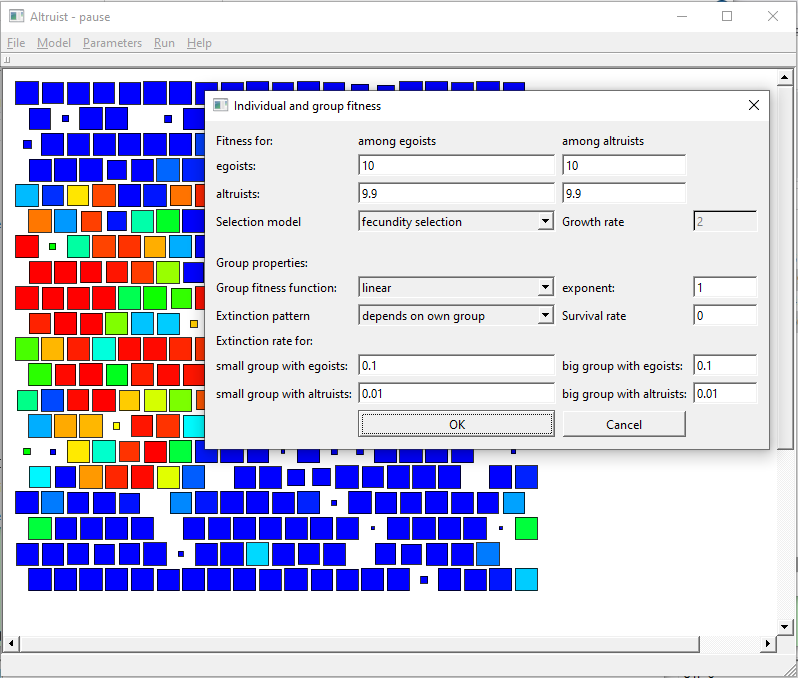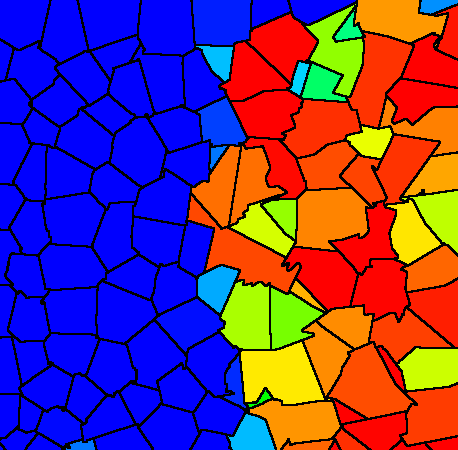Computer simulation of biological evolution in structured populations
Open source software package 'Altruist'
by Agner Fog
Contents:
Altruist is an open source software package for simulation of genetic evolution in
structured and viscous populations. The purpose is to test a number of scientific models for
evolution, including group selection, Wright's shifting balance theory, and punctuated equilibria. Random events are controlled by a high-quality random number generator and statistical distribution functions.
The program is free and open source.
The program has a frindly user interface with full control of all parameters,
graphic representation of results, automatic search for limiting parameter values, and file output.
 User interface of Altruist program.
User interface of Altruist program.
A number of different theoretical models can be simulated, including the following:
Island model of group selection with selective extinction
The Island model is the traditional model of group selection, inspired by the analogy with individual selection. A genetic trait called altruism is benefitting the group but decreasing the individual fitness of the altruist.
An animal species is living in an archipelago where each island is inhabited by a group of animals. The population of an island can go extinct. New groups are formed by members of a nearby group colonizing an empty island. The probability of extinction of a group is a function of the number of altruists in the group.
Selective migration model
This model is not based on group extinction but on selective migration between groups living on islands. This model assumes that groups with many altruists have a higher fertility for both egoist and altruist members. Such groups are able to send out more emigrants than groups dominated by egoists. All emigrants have equal probability of successfully entering another group.
Selective dispersal model
This model is based on selective forming of daughter groups.
Groups living on separate islands can go extinct with a constant probability. Empty islands are colonized by founder populations from a neighbor group. The probability that the founder population comes from a particular neighbor group depends on the proportion of altruists in that group.
Outsider exclusion model
The outsider exclusion model is an extension of the island model and the selective dispersal model. A gene named endogamy controls a trait that makes group members prevent outsiders from entering the group. This gene may spread, even if it does not increase fitness, simply because it reduces competition from alternative genes.
Conformity model
The conformity model is an extension of the island model. A gene named conformity controls a trait that reduces the fitness of egoists in groups dominated by altruists or vice versa. In other words, the fitness of egoists is lower than the fitness of altruists in groups dominated by both altruism and conformity. In other cases, egoists have higher individual fitness than altruists.
Altruistic punishment
Group members with a certain gene are promoting altruism by punishing any group member that behaves egoistically.
Haystack model
Groups of mice live in haystacks. Each haystack is colonized by a small founder population early in the season. Their descendants stay in the same haystack until the end of the season when the haystacks are removed. In a second period where there are no haystacks, the mice live elsewhere and the entire metapopulation is mixed until next season when new haystacks are colonized. Altruists limit their consumption of resources, while egoists eat more than necessary. Haystacks with altruist mice leave more mice to the metapopulation at the end of the haystack season than haystacks with egoist mice. This mechanism is also called intrademic group selection.
Group territoriality model
This is a new model introduced with the Altruist program. A species of social animals live in groups. Each group has its own territory. A group can conquer territory from a neighbor group, possibly through violent conflict. The winning group will gain more territory, while the territory of the losing group gets smaller. The carrying capacity of a group territory is proportional to its area. Altruists are willing to fight for their group in territorial conflicts, while egoists are not. Groups with many altruists have higher ability to win territory from weaker neighbor groups. Larger territories can feed more group members and allow the groups to grow bigger. The population of a losing group will be reduced because the smaller territory can sustain fewer individuals.
This picture shows a snapshot of evolution according to this model. Red territories are inhabited by altruists, blue by egoists, and territories with intermediate colors by a mixture. Territories can grow by conquering neighbor territory. When a territory becomes too big, it is split in two. The irregular shape of especially the altruist territories is a result of frequent moving of the borders.

Regality model
The regality model is similar to the group territoriality model, but based on leadership rather than altruism. Fighting for one’s group involves a collective action problem when the cost of fighting is borne by the individual fighter while the benefit resulting from the actions of this individual is divided between all group members. A theory called
regality theory explains how cooperation can be achieved through strong leadership. Humans have evolved a psychological response pattern that makes us support a strong leader in case of war or perceived collective danger, according to regality theory. The leader can compensate individuals for the cost of fighting by rewarding brave warriors and punishing cowards and defectors. The trait called regality does not involve an increased willingness to fight, but an increased willingness to support a leader who can make everybody fight, including individuals who do not have the regality trait.
The simulation model will test whether collective fighting can be explained by individuals supporting a strong leader.
Epistasis model
This model has nothing to do with the previous models. This model illustrates an example of how epistasis can lead to evolution through punctuated equilibria. Imagine a species where a new mutant allele, A, is decreasing fitness. Another new mutant allele, B, at a different locus is also decreasing fitness. But fitness is increased when both mutant allele A and B are present in the same individual organism. This model explores the possibility that the AB combination will appear by chance and then spread in the population. The probability that this happens depends on the viscosity of the population.
If the AB combination is starting to spread through the population, then another mutant allele, C, at a third locus can increase the fitness further and result in a new variant ABC.
Computer simulation of group selection models. Working paper, 2024.
Simulation of punctuated equilibria
Available on Github
Agner Fog: Simulation of Evolution in Structured Populations:
The Open Source Software Package Altruist.
Biotech Software & Internet Report.
Vol. 1, No. 5, p. 226-229. 2000.
A Group Selection Model of Territorial War, Xenophobia and Altruism in Humans and other Primates.
Proceedings of the XV world congress of the International Union for Prehistoric and Protohistoric Sciences Lisbon 2006. Publishers of British Archaeological Reports, Oxford 2009.
Warlike and peaceful societies. This book develops a theory
explaining why people are willing to fight for their group despite the costs. The theory is tested on data from both
ancient and contemporary societies.
634284
 User interface of Altruist program.
User interface of Altruist program.
